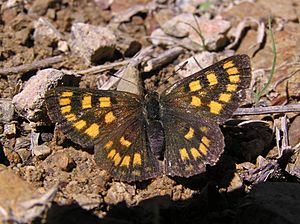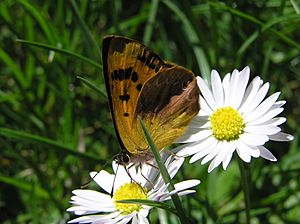Glade copper facts for kids
Quick facts for kids Glade copper |
|
|---|---|
 |
|
 |
|
| Scientific classification | |
| Synonyms | |
|
The Lycaena feredayi, also known as the glade copper, is a type of butterfly. It belongs to the Lycaenidae family. This butterfly is special because it is found only in New Zealand. This means it is an endemic animal.
Glade copper butterflies have a wingspan of about 25 to 32 millimeters. This is roughly the length of a small paperclip. You can usually see adult butterflies flying from November to December. They also fly from February until early April.
Contents
Identifying the Glade Copper
What the Glade Copper looks like
Glade copper butterflies are mostly orange. They have black outlines and lines on their wings. Their antennae are striped, and the edges of their wings are also colored.
It's hard to tell male and female glade coppers apart just by looking at their colors or patterns. They look very similar! The only way to tell them apart is by looking closely at the shape of their abdomen. Males have a long, narrow abdomen. Females have a short, swollen one.
Even when they are young, glade coppers look alike. Unlike other copper butterflies, their wing patterns and colors do not change much. They stay pretty consistent throughout their lives.
Where Glade Coppers Live
Glade Copper's natural home
Glade coppers are only found in New Zealand. This means they are native to this country and don't naturally live anywhere else in the world.
Where to find them in New Zealand
As their name suggests, glade coppers often live in forest glades. These are open, sunny areas within a forest. You can also find them along waterways and in gullies. They live in different places across both the North and South Islands of New Zealand.
They have been seen in most parts of the South Island. They are also found in certain areas of the North Island. These include the eastern side of the Dunstan Mountains, Central Otago, and Wellington.
Glade Copper Habitat
Glade coppers might not seem very common. This is because their host plants, which their larvae eat, have become less available. However, they are actually quite abundant in nature.
You can find them in many places where their larval host plant grows. Besides forest glades, they live in various other spots. Glade coppers are also "sedentary." This means they don't travel far from where they were born. They usually stay close to the plants their larvae need for food.
Glade Copper Ecology
Glade Copper reproduction
The glade copper butterfly has two main breeding periods, called "broods," each year.
The first brood happens in late November and December. The female butterflies lay their eggs near the plants that the larvae will eat. These larvae then grow and turn into butterflies during the same season. However, some of these larvae will not become pupae until after winter. They will then emerge as butterflies during the second brood. For example, some larvae from the first brood become pupae in January. This means they will emerge as butterflies in February.
The second brood takes place in February and March. The same pattern happens again. Some larvae from these eggs will become pupae and emerge as butterflies within these two months. Others will wait until the first brood of the next season to emerge.
Glade Copper life cycle
Like all butterflies, glade coppers go through four main stages in their life cycle. Each stage looks different and serves a special purpose.
- Ovum (Egg): The life of a glade copper starts as an egg. These tiny eggs are usually found on the underside of the leaves of their food plants. Female butterflies walk along the plant stem to lay their eggs. They often lay them on older leaves, about 5 to 10 centimeters away from new growth. The eggs are laid in the middle of the leaf, not too close to the edge. Usually, only one egg is laid per leaf by a single female. However, you might find several eggs on one leaf if different females have laid them there.
- Larvae (Caterpillar): When the egg hatches, a yellow-green larva emerges. After it starts to eat, it turns leaf-green. It also gets small white spots and reddish hairs. A reddish-brown line runs down its back. The main plant these larvae eat is called Pohuehue. They likely eat other types of Pohuehue too. Larvae live for about 6 weeks and go through 4 "instars." An instar is a period between shedding their skin. In the first three instars, they chew small round holes on the underside of leaves. In the fourth and final instar, they start eating the edges of the leaves.
- Pupa (Chrysalis): At this stage, the larva turns reddish-brown. It grows greenish-brown wing cases and a pale brown eye spot. The pupa hides inside a "tent" made of leaves held together with silk. This forms a cocoon-like structure. Glade coppers have stiff hairs on their bodies, which gives them a rough texture. Pupation happens when they attach themselves to the food plant using their cremaster. This is a special hook-like part at their rear end. This stage usually lasts about 17 days, but it can be longer. Pupae can be very hard to find in the wild.
- Imago (Adult Butterfly): This is the final stage, also known as the flying stage. Adult glade coppers have darker markings on their wings compared to other copper butterflies. Their wingspan is between 25 and 32 millimeters. As mentioned, males have long, narrow abdomens, while females have short, swollen ones. An adult glade copper usually lives for about 7 days.
When male glade coppers are looking for a mate, they flutter very quickly in many directions. They often stop to rest when they are trying to attract females. Scientists haven't studied their courtship in detail yet. However, it's been seen that interactions between different types of copper butterflies help them choose their habitats.
What Glade Coppers eat
Like other copper butterflies, glade coppers feed on a climbing plant called Muehlenbeckia australis. This plant is also known as Pohuehue. They also lay their eggs on this plant. If you find Pohuehue growing, there's a good chance you might find glade coppers nearby.
The presence of these butterflies is often linked to when their food plant flowers. The times when the butterflies are flying match up with the flowering periods of Pohuehue. Glade coppers are also quite curious butterflies. They will often investigate other butterflies or creatures if someone approaches their habitat.
Male and female glade coppers feed differently. Males feed quickly at a flower cluster. Then they often fly up to 2 meters before feeding again. Their feeding is often mixed with basking in the sun or looking for mates. Females, on the other hand, take more time to feed. They fly directly to the closest flower cluster and can feed continuously for 5 to 30 minutes.
Glade Copper predators and parasites
The number of copper butterflies can be affected by wasps, especially paper wasps. Wasps hunt these butterflies because they are a good source of protein for their own larvae.
There have also been reports of tiny insects called Ichneumonids parasitizing glade copper larvae. These parasites kill their host by feeding on them, either from the inside or outside. This happens when the larvae are getting ready to become pupae. More studies are needed to fully understand these interactions.
Other Interesting Facts
Like many butterflies, the glade copper flies when the sun is out. They are usually active between 7:30 AM and 6:00 PM.
The way males and females fly is different. Males fly fast in a zig-zag pattern. They often stop to sunbathe, eat, or try to attract females. Females fly slower and in a straighter line than males.
The glade copper is part of the larger group of Copper butterflies. Scientists are still studying many parts of their lives. All current studies and new observations of Copper butterflies are being reviewed. This is to see if they need to be re-classified. Some recent environmental research suggests that the glade copper might even be split into two different species in the future.

